GIGABYTE GA-J1800N-D2H Review: Dual Core Bay Trail-D at $69
by Ian Cutress on December 26, 2014 11:00 AM EST- Posted in
- Motherboards
- Intel
- Bay Trail
CPU Performance
Readers of our motherboard review section will have noted the trend in modern motherboards to implement a form of MultiCore Enhancement / Acceleration / Turbo (read our report here) on their motherboards. This does several things, including better benchmark results at stock settings (not entirely needed if overclocking is an end-user goal) at the expense of heat and temperature. It also gives in essence an automatic overclock which may be against what the user wants. Our testing methodology is ‘out-of-the-box’, with the latest public BIOS installed and XMP enabled, and thus subject to the whims of this feature. It is ultimately up to the motherboard manufacturer to take this risk – and manufacturers taking risks in the setup is something they do on every product (think C-state settings, USB priority, DPC Latency / monitoring priority, memory subtimings at JEDEC). Processor speed change is part of that risk, and ultimately if no overclocking is planned, some motherboards will affect how fast that shiny new processor goes and can be an important factor in the system build.
For reference, the J1800N-D2H does not use any form of MultiCore Turbo.
Point Calculations – 3D Movement Algorithm Test: link
3DPM is a self-penned benchmark, taking basic 3D movement algorithms used in Brownian Motion simulations and testing them for speed. High floating point performance, MHz and IPC wins in the single thread version, whereas the multithread version has to handle the threads and loves more cores. For a brief explanation of the platform agnostic coding behind this benchmark, see my forum post here.
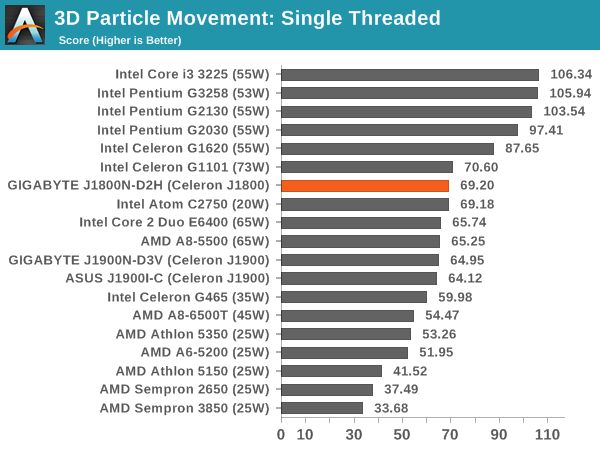
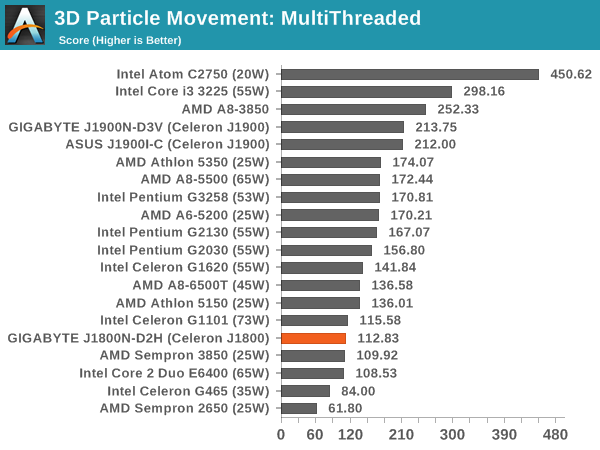
Compression – WinRAR 5.0.1: link
Our WinRAR test from 2013 is updated to the latest version of WinRAR at the start of 2014. We compress a set of 2867 files across 320 folders totaling 1.52 GB in size – 95% of these files are small typical website files, and the rest (90% of the size) are small 30 second 720p videos.
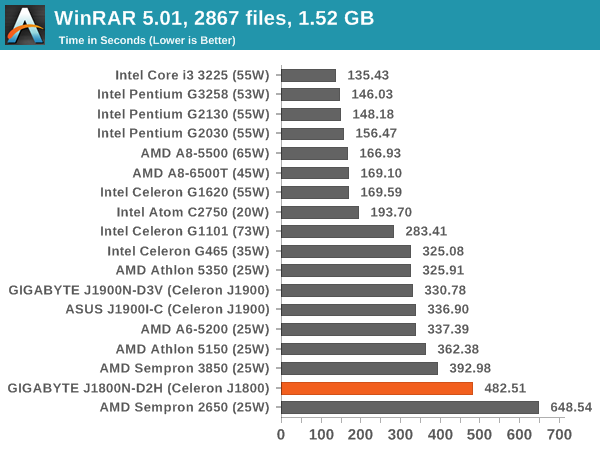
Image Manipulation – FastStone Image Viewer 4.9: link
Similarly to WinRAR, the FastStone test us updated for 2014 to the latest version. FastStone is the program I use to perform quick or bulk actions on images, such as resizing, adjusting for color and cropping. In our test we take a series of 170 images in various sizes and formats and convert them all into 640x480 .gif files, maintaining the aspect ratio. FastStone does not use multithreading for this test, and thus single threaded performance is often the winner.
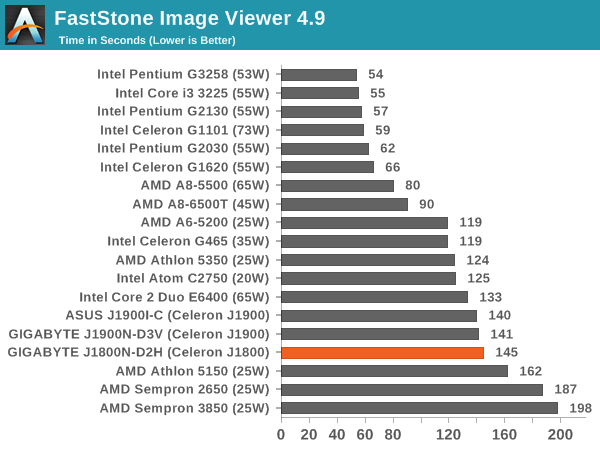
Synthetic – 7-Zip 9.2: link
As an open source compression tool, 7-Zip is a popular tool for making sets of files easier to handle and transfer. The software offers up its own benchmark, to which we report the result.
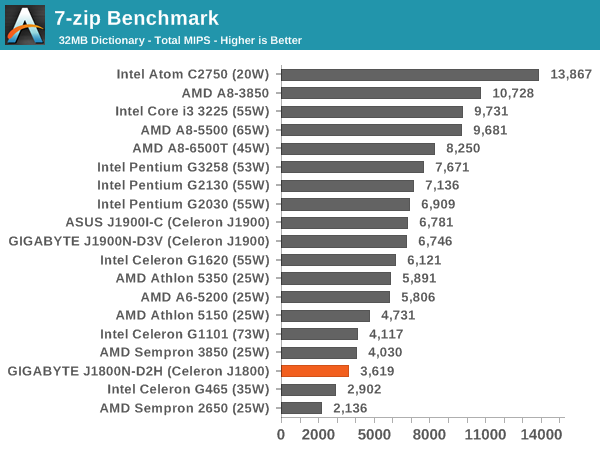










38 Comments
View All Comments
lioncat55 - Friday, December 26, 2014 - link
When ever I see a system like this I want to build a Plex server. But it never seems like the CPU is enough.LoneWolf15 - Friday, December 26, 2014 - link
@lioncat55 - Asrock makes the Q2900-ITX , a J2900 Bay Trail quad core. You'll probably find it a little more suitable.I went Core i3-3225 at the time I built my HTPC due to the HD4000 graphics. Still working well running XBMC Gotham.
xbenny - Saturday, December 27, 2014 - link
@lioncat55 - I hear you man I'm in the same quest check out this review of Q2900-ITX @techspot http://www.techspot.com/review/882-intel-pentium-j... @LoneWolf - still not enough for on-the-fly-transcoding for Plex serverStevoLincolnite - Saturday, December 27, 2014 - link
Give it time.These chips aren't even in the same league as the Core 2 processors from 6-7 years ago in terms of performance-per-clock, but they do use a tiny fraction of the energy.
They're certainly a big step up from the old Atoms.
Might start getting competitive with Nahelem class chips in the next 3-4 years, which is when things would start to get interesting.
barleyguy - Monday, December 29, 2014 - link
You can get an AMD FX-6300 for $89, and throw it on a cheap motherboard. It works great for Plex; the 6 integer cores are surprisingly good at transcoding. I'm doing 1080p full Bluray transcoded to 20 Mbps for playback across powerline ethernet.It does use way more electricity than one of these though.
Another decent Plex server is the NVidia Jetson board. There's an accelerated Plex build for it. It's almost $200, but includes the CPU, RAM, and 16 GB of storage, so it's basically turnkey. The power usage on that is about 7 watts typical and 15 watts peak, not counting the hard drive the movies are on. (This option does require some Linux knowledge. You need to update Linux for Tegra and set up Plex server as chroot.)
$.02
KWIE - Wednesday, January 7, 2015 - link
@lioncat55 - I have a FreeNAS box with Plex Server running inside a jail on an Asrock Q1900-ITX, basically the quad core version of this, but with lower per-core frequency. There are other versions available also including one with DC-in. The above model also has 4 SATA ports (vital for me with a 4 drive ZFS setup). I boot from a Sandisk Cruzer Fit USB drive with no issues.I have one large, slow fan blowing over the drives in the entire case and never have any heat issues. Very, very happy with it... and now considering building another for a family member.
dragosmp - Friday, December 26, 2014 - link
Great review, I like the comparison with HP's Stream. To push it further I would say in this particular case it's obvious one should pick up the OEM made, but what about if someone wants a quad BT? Then for 20$ more someone can get twice the performance for 5% in system cost. It's endless reasoning, but I just wanted to point out this bitbill.rookard - Friday, December 26, 2014 - link
Agreed. I have the ASRock Q1900M (quad-core, full size DIMMs, a few more x1 slots and a full x16 (x1 wired) slot) and that allows for quite a bit more flexibility. It's still a very small board - same depth as ITX, just a little more width. The extra x1 slots could allow for some extra sata connectivity, the x16 could allow for a more powerful gpu (the intel solution onboard is marginal at best - only 4EU's).Overall though, armed with a SSD (Samsung 830) it's more than adequate for HTPC duty.
ddriver - Friday, December 26, 2014 - link
The lack of performance is otherworldly.I guess gaming benches were a logical component of the review for this product, seeing how it is definitely intended for such tasks. /sarcasm
To hell with stuff like media playback or a file server, workloads such a product is actually suited for. Who cares how this product works for stuff it is actually usable for.
Gigaplex - Friday, December 26, 2014 - link
Insufficient SATA ports for this to be used as a file server.